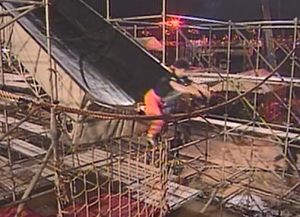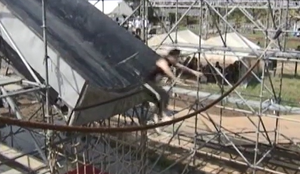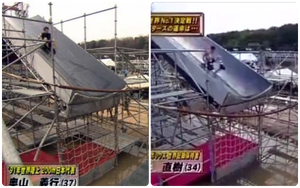Flying Chute (フライングシュート) is a First Stage obstacle introduced as part of the course's renewal in SASUKE 18 after Nagano Makoto's Kanzenseiha in the previous tournament.
Competitors had to slide down a chute, which would have a starting height of 6.3 meters, grab onto a rope placed a certain distance away from the slide, then use the momentum to reach a net placed underneath the slide. If the competitor fails the obstacle, another net located just above the water helps make the obstacle safer, as the velocity that they travel means that if the net were not there the competitor would be severely injured.
This obstacle was proven to be one of the hardest obstacles in Shin-SASUKE's First Stage, eliminating top competitors like Yamamoto Shingo, Nagasaki Takamasa, Shiratori Bunpei, Nagasaki Shunsuke, Nagano Makoto, Iketani Naoki, Urushihara Yuuji, and Brian Orosco.
The obstacle had four different versions, with Nagano being the only competitor to attempt all four versions.
First Version[]

Nagasaki Takamasa attempting Flying Chute in SASUKE 18

Nagasaki Takamasa attempting Flying Chute in SASUKE 18, viewed from close range
SASUKE 18 saw a completely course redesign, with many new experimental obstacles was introduced, and Flying Chute was one of them. Like many other new obstacles, the SASUKE 18 version of Flying Chute by far was the easiest and the most basic version of it. The distance to the rope was pretty close to the end of the slide and it was put at around the height of the competitors' shoulder in sitting position.
To clear this, competitors just need to grab the rope correctly and grabbing the net tightly, as this version required none of the timing, speed, and strategies required in future versions. Most of this version's failures happened due to the competitors either grabbing the rope by their palms, which happened to Satō Hiromichi, or they reach the net, but fail to keep hold of it, which happened to Yamamoto Shingo.
Despite being dubbed as the easiest version, it is still deadly, eliminating five competitors who attempted this version, probably due to the unfamiliarity to the obstacle. It will be modified in the following tournament.
Second Version[]

Nagano Makoto attempting modified Flying Chute in SASUKE 19

Comparison when Nagano Makoto reaching for the rope of Flying Chute in SASUKE 18 (Left) and 19 (Right)
SASUKE 19 featured the hardest version of many obstacles from Pole Maze, Jumping Spider to Flying Chute. The rope in this version was put further than the original version and at much higher height, now being put above the competitors' head in sitting position.
To clear this, competitors needed great speed in order to gain enough momentum to reach the net and great timing. If they jump too early, they could flip over the rope, but if they jump too late, as happened with Nagasaki Takamasa and Nagano Makoto, they wouldn't be able to hold onto the rope and would fall into the water. On top of that, competitors also needed to hold the rope only with their bare hand, otherwise they would not be able to reach the net. Because of the great speed required to gain momentum, many competitors tried to reach the net on the first rebound, as Nagasaki Shunsuke tried to attempt, only for him to going down to the water.
With SASUKE 19 having only two First Stage clears, the worst tournament result, the producers decided to modify the Flying Chute again for the following tournament.
Third Version[]

Takeda Toshihiro attempting modified Flying Chute in SASUKE 20

Takeda Toshihiro attempting Flying Chute in SASUKE 20, viewed from close range

Takeda Toshihiro attempting Flying Chute in SASUKE 20, viewed from the front
Due to the extremely horrible result in SASUKE 19, the producers toned down the Flying Chute in order to make the obstacle a little easier for the competitors. To do this, they moved the rope vertically down, so they were at the same height as in the original version, but also the same distance away from the slide as in the previous version. In addition, the rope was thicker which minimizes the problem of getting whiplashed easily.
The modifications made competitors attempt Flying Chute with new strategies:
- The competitors went fast, trying to endure the whiplash, then made it to the net on the rope's first rebound.
- The competitors went slow and tried to land on the rope with enough force to get the necessary momentum to reach the net.
These strategies created new ways to struggle on the obstacle, with some competitors failed to generate enough momentum and were left dangling until time running low, as happened to Takeda Toshihiro where he would time out on the Rope Ladder.
Fourth Version[]

Ishimaru Kenjirō attempting modified Flying Chute in SASUKE 21, viewed from the front.

The distance to the rope of Flying Chute as seen during Ishimaru Kenjirō's run in SASUKE 21

Comparision of the angle of the chute between the one in SASUKE 20 and the one in SASUKE 21
With the result of SASUKE 20 was not much better than SASUKE 19, the obstacle once again was made easier in SASUKE 21, thus become one of the few obstacles in SASUKE's history to be modified in four consecutive tournaments. Now, the chute was raised to the end, making the slide becoming less steeper than previous versions. With no modification made to the rope, the rope was now placed in the lowest placement with the chute compared to previous versions. These modifications caused one of the most interesting and unique failures in history, when 2 competitors Haga Tomoya and Iketani Naoki flipped over the rope and fell straight to the water.
The strategies from SASUKE 20 version continued to play, as Yamamoto Shingo ended up touching the water with his toe while trying to build momentum to the net, ending his run there. With more competitors attempted to this version compared to the previous three, it brought fair damage to competitors, eliminating half of the competitors who attempted the obstacle despite being nerfed.
Despite the high knockout rate through out its lifespan, it was replaced by a much harder Slider Jump in SASUKE 22.
Competitors' Success Rate[]
- All results based on the TBS broadcast and external information found.
| SASUKE | Clears | Attempts | Percentage |
|---|---|---|---|
| 18 | 9 | 14 | 64.29% |
| 19 | 4 | 14 | 28.57% |
| 20 | 9 | 13 | 69.23% |
| 21 | 11 | 22 | 50% |
| Total | 33 | 63 | 52.38% |
